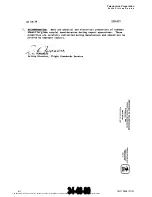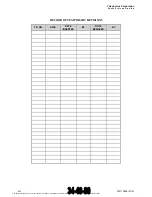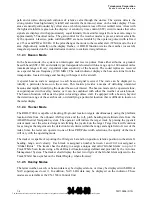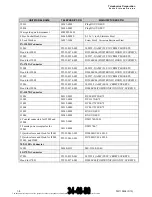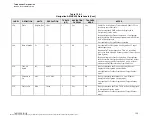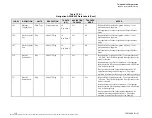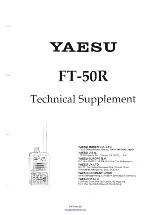
Telephonics Corporation
R
A D A R
S
Y S T E M S
D
I V I S I O N
1-4
TM113806 (3/10)
path and can also distinguish corridors of relative calm through the storms. The system detects the
strong returns from high-density rainfall and converts them into red areas on the radar display. These
areas are usually surrounded by yellow areas, which represent areas of lower rainfall rates. Areas with
the lightest rainfall are green on the display. A sensitivity time control (STC) circuit ensures that echo
signals are displayed with approximately equal intensity from similar targets from near zero range to
approximately 55 nautical miles. The gain control for the weather modes is preset, and not selectable
by the operator. Likewise, pulse width and PRF are not selectable by the operator; pulse width is fixed
at 2.35 ms and PRF at 200 Hz. If the pilot changes the mode to the weather alert (WXA) mode, the red
area (high-density rainfall) on the display flashes. A HOLD function retains the weather (or search)
image last presented on the radar indicator in order to evaluate its significance.
1.1.2.3 Beacon Mode
In the beacon mode, the system can interrogate and receive pulses from either airborne or ground-
based I-band (SST-181E and similar type) transponders located within a range up to 160 nautical miles
(maximum range will vary, dependent upon sensitivity of the beacon). The coded replies are received
on a special beacon frequency (9310 MHz). The radar indicator displays the beacon returns from the
transponders, located in range and bearing with respect to the aircraft.
A special beacon code is assigned to each beacon signal received. The code can be displayed to
identify a particular beacon on the screen. This feature provides a means of defruiting unwanted
beacons and rapidly identifying the desired beacon of interest. The beacon mode can be operated alone,
or superimposed with overlay modes; or it can be combined with either the weather or search mode.
The beacon function will assist the pilot in locating surface craft, if equipped with a beacon, beyond
the detection range of the search mode, or identifying a particular location that is difficult to locate on
the radar display.
1.1.2.4 Tracker Mode
The RDR-1700A is capable of tracking 20-ground location targets simultaneously using the platform
location data from the onboard AMS system and the roll, pitch heading and altitude data from the
AHARS Inertial Navigation system. The operator will initiate the target track by placing the joystick
cursor mark over the selected target and clicking the joystick on the target. Target track will continue
for as long as the target meets the detection level criteria within the range and angle field of view of the
radar. Since the radar can operate in one of three PRF/Pulse width selections, the quality of the track
will vary with the operating mode.
The tracker is capable of reporting the 20 targets Lat and Lon position, relative position to the aircraft,
heading, range, and velocity. Each track is assigned a number between 1 and 20 if not assigned a
‘Global Idents’. The tracker has the ability to assign a unique and valid ‘Global Idents’ to up to 10
Track While Scan tracks using a Track Block Allocation range defined and provided by the Avionics
Management System. The tracker shall display the last two digits of the Global Ident adjacent to the
Track Whilst Scan symbol on the Radar Display, when allocated.
1.1.2.5 Overlay Modes
The radar weather, search, or beacon data may be displayed alone, or it may be displayed with HDG or
NAV superimposed over it. In addition, NAV LOG data may be displayed on the indicator. These
modes are selectable at the CN-1506A Control Unit.
The document reference is online, please check the correspondence between the online documentation and the printed version.



